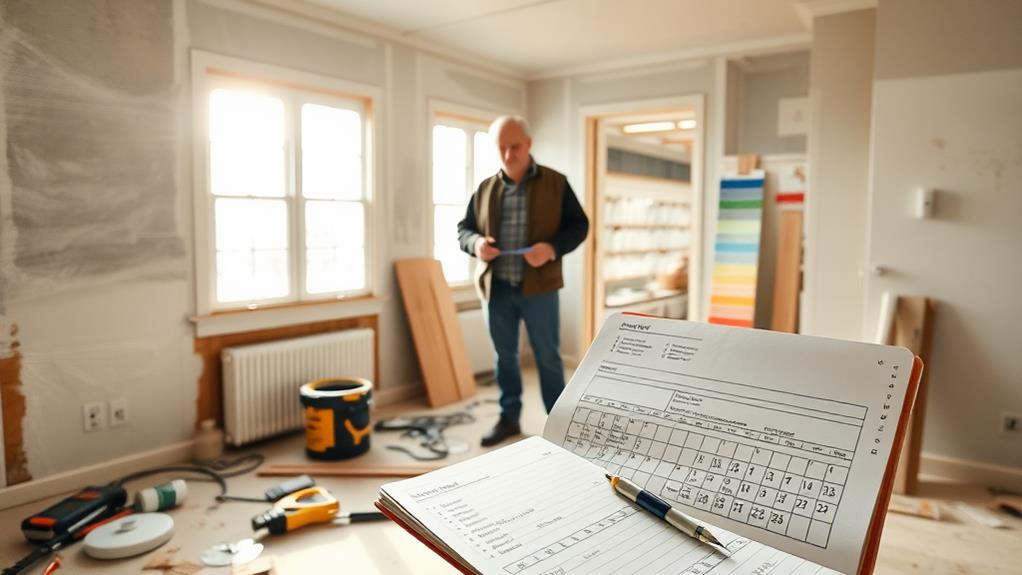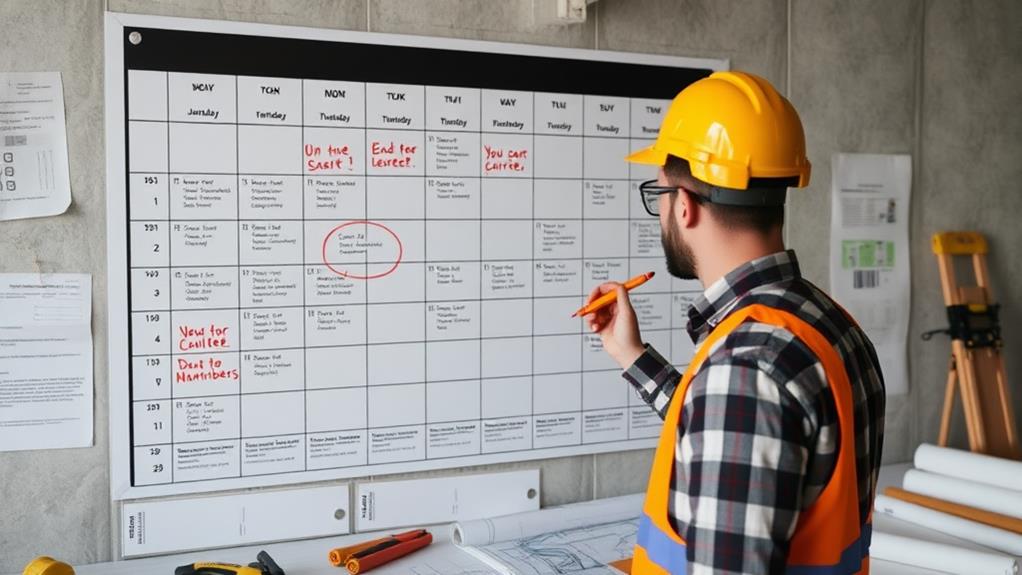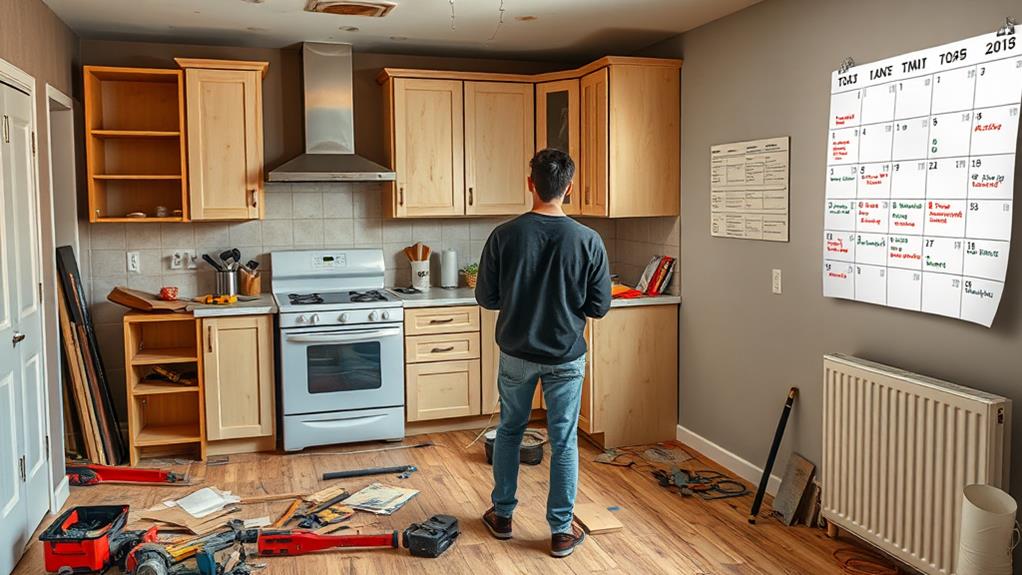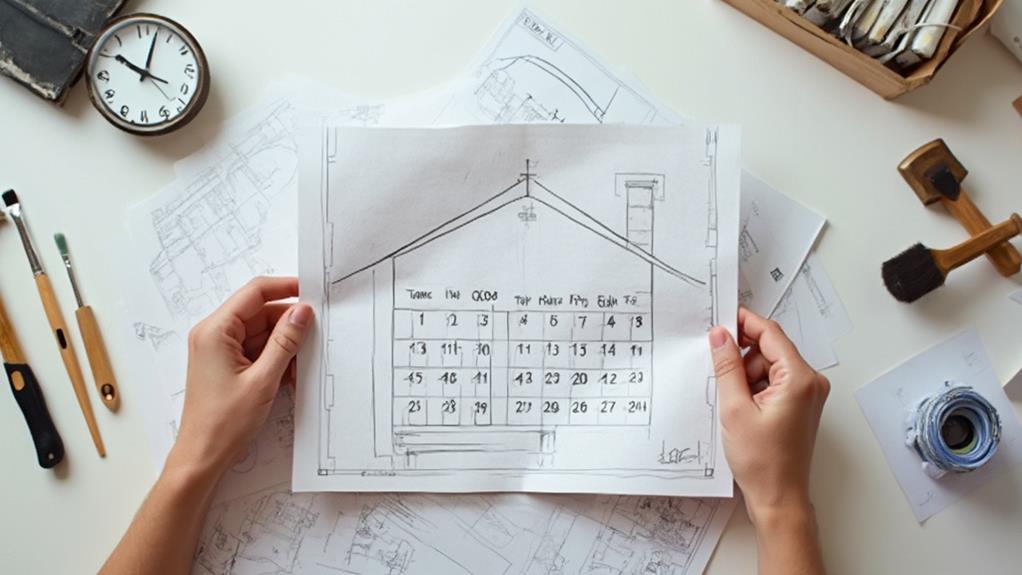Creating and sticking to a realistic renovation timeline requires thorough planning and clear goal-setting. Start by carefully assessing your project scope and prioritizing tasks. Set specific, measurable objectives that align with your budget and long-term plans. Research extensively, consulting professionals and gathering inspiration from various sources. Develop a detailed budget, including a contingency fund for unexpected issues. Hire reliable professionals with proven track records and establish clear communication channels. Break the project into distinct phases with realistic timeframes, considering potential delays and dependencies. By following these steps and staying flexible, you'll be better equipped to manage your renovation effectively and efficiently.
Assess Your Project Scope

Before diving into any renovation project, it's crucial to thoroughly assess its scope. This initial step involves carefully evaluating all aspects of the work to be done, from minor cosmetic updates to major structural changes. Consider the size of the space, the extent of repairs or modifications needed, and any potential challenges that may arise during the process.
Begin by creating a detailed list of all tasks required, including demolition, construction, electrical work, plumbing, painting, and finishing touches. Prioritize these tasks based on their importance and logical order of completion. Take into account any permits or inspections that may be necessary, as these can significantly impact your timeline.
Next, evaluate your available resources, including budget, materials, and labor. Determine whether you'll be handling the work yourself or hiring professionals. If outsourcing, factor in time for researching and hiring contractors, as well as potential wait times for their availability. Be realistic about your own skills and time constraints if planning a DIY approach.
Set Clear Renovation Goals
Setting clear renovation goals is a crucial step in planning a successful project. These goals serve as a roadmap for your renovation, guiding decision-making and helping you stay focused throughout the process. Begin by identifying your primary objectives, such as increasing living space, improving energy efficiency, or updating outdated features. Prioritize these goals based on importance and budget constraints.
Next, break down each goal into specific, measurable targets. For example, if your goal is to create a more functional kitchen, specify the desired improvements, such as adding storage space, upgrading appliances, or reconfiguring the layout. Ensure your goals align with your long-term plans for the property and consider any potential impact on resale value.
Involve all stakeholders in goal-setting discussions to ensure everyone's needs and preferences are considered. This collaborative approach can help prevent conflicts and misunderstandings later in the project. Document your goals in writing, including any relevant details or constraints, and refer to them regularly throughout the renovation process. By establishing clear, well-defined objectives, you'll be better equipped to make informed decisions and maintain focus on what truly matters in your renovation project.
Research and Plan Extensively

Thorough research and extensive planning lay the groundwork for a successful renovation project. Begin by gathering inspiration from various sources, including home improvement magazines, websites, and social media platforms. Conduct in-depth research on materials, design trends, and construction techniques relevant to your specific renovation goals.
Consult with professionals, such as architects, interior designers, and contractors, to gain expert insights and refine your ideas. Obtain multiple quotes and compare services to ensure you select the right team for your project. Create detailed floor plans, mood boards, and material lists to visualize the end result and streamline decision-making.
Develop a comprehensive project plan that outlines each phase of the renovation, including demolition, construction, and finishing touches. Break down larger tasks into smaller, manageable steps and assign realistic timeframes to each. Consider potential obstacles and build in buffer time to accommodate unexpected delays or changes.
Research local building codes, permit requirements, and homeowners association regulations to ensure compliance and avoid costly setbacks. By investing time in thorough research and meticulous planning, you'll establish a solid foundation for your renovation timeline and increase the likelihood of a smooth, successful project.
Create a Detailed Budget
A well-crafted budget serves as the financial blueprint for your renovation project. It helps you allocate resources effectively, anticipate expenses, and avoid costly surprises.
Begin by listing all anticipated costs, including materials, labor, permits, and equipment rentals. Research prices thoroughly and obtain multiple quotes from contractors to ensure accuracy.
Include a contingency fund of 10-20% to cover unexpected issues or changes. Break down the budget into categories such as demolition, structural work, electrical, plumbing, finishes, and fixtures. This level of detail allows for better tracking and adjustment throughout the project.
Consider the timing of payments and how they align with project milestones. Some contractors may require deposits or progress payments, so factor these into your cash flow planning. Don't forget to account for temporary living arrangements if necessary during the renovation.
Review your budget regularly as the project progresses and be prepared to make adjustments. Keep detailed records of all expenses and compare them against your initial estimates. This ongoing monitoring will help you stay on track financially and make informed decisions if trade-offs become necessary.
Hire the Right Professionals

Assembling the right team of professionals is crucial for the success of your renovation project. Begin by researching and interviewing multiple contractors, architects, and designers who specialize in your type of renovation. Check their credentials, licenses, and insurance coverage. Request and contact references to gauge their past performance and reliability.
When selecting professionals, consider their communication style, willingness to collaborate, and ability to work within your budget and timeline. Ensure they understand your vision and can provide realistic estimates for both time and costs. Look for professionals who are transparent about potential challenges and offer solutions proactively.
Once you've chosen your team, establish clear lines of communication and expectations. Create a detailed contract that outlines the scope of work, payment schedule, and project milestones. Regular meetings and progress updates will help keep everyone aligned and accountable throughout the renovation process.
Remember that the cheapest option isn't always the best. Investing in experienced, reputable professionals can save you time, money, and stress in the long run by avoiding costly mistakes and delays. A skilled team will help ensure your renovation stays on track and meets your expectations.
Establish Project Milestones
Setting clear project milestones is essential for maintaining momentum and tracking progress throughout your renovation. Begin by breaking down your project into distinct phases, such as demolition, structural work, plumbing, electrical, drywall, painting, and finishing touches. Assign realistic timeframes to each phase, considering potential delays and dependencies between tasks.
Create a detailed timeline that outlines specific goals and deadlines for each milestone. This should include start and end dates for major components of the renovation, as well as key decision points for selecting materials, fixtures, and finishes. Ensure that your timeline accounts for permit approvals, inspections, and any necessary lead times for custom or specialty items.
Regularly review and update your project milestones as work progresses. This will help you identify any areas where the project may be falling behind schedule and allow you to make adjustments accordingly. Communicate these milestones clearly to all involved parties, including contractors, subcontractors, and suppliers, to ensure everyone is working towards the same goals. By establishing and adhering to well-defined project milestones, you'll be better equipped to manage your renovation timeline effectively and achieve your desired results.
Build in Buffer Time

Despite careful planning, renovation projects often encounter unexpected challenges and delays. To account for these inevitable setbacks, it's crucial to build buffer time into your renovation timeline. This extra cushion allows for flexibility and helps maintain project momentum when unforeseen issues arise.
When creating your timeline, add a 20-25% buffer to each major phase of the project. For example, if you estimate that demolition will take one week, allocate 8-9 days instead. This approach provides a more realistic timeframe and reduces stress when delays occur.
Consider potential obstacles such as weather-related issues, material shortages, or scheduling conflicts with subcontractors. Factor in time for inspections, permit approvals, and any necessary revisions to plans. Additionally, include buffer time for decision-making processes, as selecting finishes and materials often takes longer than anticipated.
Communicate Effectively With Contractors
Establishing clear communication with your contractors is fundamental to keeping your renovation project on track. Set up regular check-ins, whether daily or weekly, to discuss progress, address issues, and review upcoming tasks. Create a centralized communication channel, such as a project management app or group chat, to ensure all parties have access to the same information.
Be proactive in your communication, asking questions and seeking clarification when needed. Promptly respond to contractors' inquiries to avoid delays. Clearly articulate your expectations and project vision, providing detailed specifications and references when possible. Encourage open dialogue about potential challenges or setbacks, fostering an environment where contractors feel comfortable sharing concerns.
Document all important conversations and decisions in writing, including any changes to the project scope or timeline. This helps prevent misunderstandings and provides a record for future reference. When discussing timelines, be realistic and consider factors like material delivery times and potential unforeseen issues. Regularly review the project schedule with your contractors, adjusting as necessary to maintain a realistic timeline. By prioritizing effective communication, you can minimize delays, reduce misunderstandings, and keep your renovation project running smoothly.
Stay Flexible and Adapt

While a well-planned renovation timeline is crucial, the ability to stay flexible and adapt to unforeseen circumstances is equally important. Renovation projects often encounter unexpected challenges that can impact the timeline, such as hidden structural issues, delayed material deliveries, or unfavorable weather conditions. Maintaining a flexible mindset allows you to navigate these obstacles more effectively and minimize stress.
To stay adaptable, build buffer time into your schedule for each phase of the renovation. This extra time can accommodate minor setbacks without derailing the entire project. Be prepared to adjust your plans and priorities as needed. If one aspect of the renovation faces delays, consider shifting focus to other tasks that can be completed in the meantime.
Regularly reassess your timeline and make necessary adjustments. Communicate any changes promptly with your contractors and other involved parties. Remember that flexibility doesn't mean compromising on quality or safety standards. Instead, it involves finding creative solutions and alternative approaches to keep the project moving forward. By embracing adaptability, you can maintain progress and achieve your renovation goals, even when faced with unexpected challenges.
Frequently Asked Questions
How Do I Handle Unexpected Issues During Renovation?
To handle unexpected issues during renovation, maintain flexibility in your schedule and budget. Communicate promptly with contractors, prioritize problems, and make informed decisions. Consider having a contingency fund for unforeseen expenses. Adapt your timeline as necessary to accommodate changes.
What Permits Are Typically Required for Home Renovations?
Like a blueprint guiding construction, permits are essential for home renovations. Common requirements include building permits for structural changes, electrical and plumbing permits for system upgrades, and zoning permits for additions or major alterations to your property.
Can I Live in My Home During Major Renovations?
Living in your home during major renovations is possible but challenging. It depends on the extent of work, available living spaces, and your tolerance for disruption. Consider safety, noise, dust, and accessibility when deciding whether to stay or relocate temporarily.
How Do Seasonal Changes Affect Renovation Timelines?
Studies show that 40% of renovations experience delays due to weather. Seasonal changes significantly impact renovation timelines. Winter can slow exterior work, while summer heat may affect indoor projects. Spring and fall are often ideal for most renovation activities.
What Are Common Renovation Mistakes That Cause Delays?
Common renovation mistakes causing delays include underestimating project scope, inadequate planning, poor contractor selection, unrealistic budgets, and failing to account for material lead times. Unexpected issues, changes mid-project, and permit delays can also significantly impact timelines.
Conclusion
In conclusion, crafting and adhering to a realistic renovation timeline requires meticulous planning, clear communication, and adaptability. By coincidence, successful renovators often find that thorough preparation aligns with smoother project execution. Establishing milestones, incorporating buffer time, and maintaining flexibility are crucial for navigating unforeseen challenges. Ultimately, a well-structured timeline, coupled with effective collaboration between homeowners and professionals, significantly increases the likelihood of completing renovations on schedule and within budget, resulting in a satisfying transformation of living spaces.

